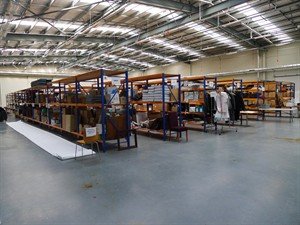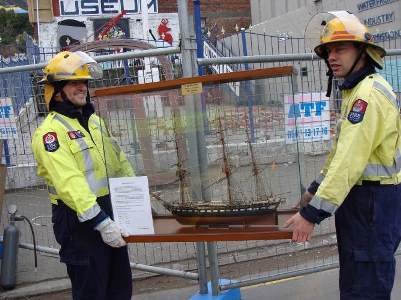A Look at the CCCRC and its Taonga
Most Cantabrians are well aware that many of the museums in Canterbury were damaged during the Canterbury earthquakes. They may have seen the damage to the museum buildings and seen photographs of volunteers rescuing precious objects before the buildings collapsed. But where do these objects go? Who is looking after collections that lost their home during the earthquakes? Many such collections are being safely stored at the Canterbury Cultural Collections Recovery Centre (CCCRC), located at the Air Force Museum in Wigram.
The Canterbury Cultural Collections Recovery Centre (CCCRC) was set up following the devastating Canterbury earthquakes of 2010 and 2011, during which many museum buildings in Canterbury were damaged or destroyed. Originally the Air Force Museum’s 6,200 square metre, $14.3 million extension was built to house aircraft and large objects for conservation, but since the earthquakes it has been home to the CCCRC and used temporarily for the restoration, storage, and rehabilitation of heritage and cultural collections from across Canterbury.
In the words of Moya Sherriff, the CCCRC administrator, “The role of the CCCRC is to provide a free space for those cultural organisations within Canterbury who have either lost their premises due to the earthquakes or are in need of temporary collection storage while their buildings are going through the EQC repair process. Each group has been given a designated storage area within the Recovery Centre and a shared workspace where organisations can re-group, assess the consequences and needs of collections and begin the processes of documentation, cataloguing and boxing, while having access to conservation treatments.”

The main floor of the Canterbury Cultural Collections Recovery Centre (CCCRC)
CEISMIC has been aware of the importance of documenting the CCCRC’s work in Christchurch for some time, and we are pleased to announce the creation of a Canterbury Cultural Collections Recovery Centre Collection in the QuakeStudies repository. The collection holds photographs of the Recovery Centre, blog posts from NZ Museums, and presentations that showcase the important role that the CCCRC has played in providing safe and secure premises for many of the region’s collections. It is hoped that documenting these activities in QuakeStudies will assist other communities in their emergency response planning and disaster recovery, and show the importance of developing strategic partnerships, locally, nationally, and internationally, to provide support and assistance in the aftermath of an emergency. Darren Hammond, Curatorial Officer at the Air Force Museum, says, “Because we have a mix of museum and military culture, we had the perfect combination of museum skills and military ‘can do’ to deal with these emergency situations.” Christchurch was fortunate to have a military museum with space that could be made available and staff with these kinds of skills. For other cities without such a facility, prior planning is of vital importance to enable a rapid response to natural disasters.
CEISMIC staff visiting the CCCRC were struck by the incredibly diverse range of artefacts stored in the facility: everything from stuffed birds to rugby memorabilia. The diversity is explained by the long list of organisations and private collectors that have stored their valuable collections with the CCCRC; groups which include The Order of St John, the RSA, the Canterbury Rugby Football Union, the Anglican Archives, Ngai Tahu, Lyttelton Museum, Kaiapoi Museum, and the Tramway Historical Society among many others.

Firefighters remove a model ship from the Lyttelton Museum
The material in the CCCRC collection tells the story of the impact of earthquakes on the Canterbury museum and arts sector, and the ways the community pulled together and supported each other. There are many lessons to be learnt from the CCCRC: issues with storage space; the wealth of material held by smaller organisations; and the perseverance and resilience of these organisations after the earthquakes. CEISMIC hopes to continue to work with the staff of the CCCRC, and the organisations that make use of it, to tell more of the recovery stories of these smaller heritage institutions.

